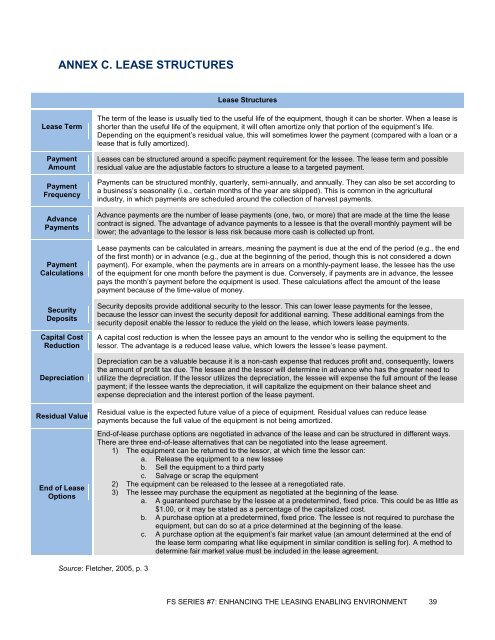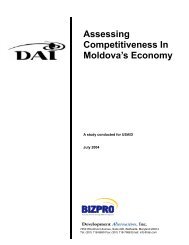Enhancing the Leasing Enabling Environment - Economic Growth ...
Enhancing the Leasing Enabling Environment - Economic Growth ...
Enhancing the Leasing Enabling Environment - Economic Growth ...
Create successful ePaper yourself
Turn your PDF publications into a flip-book with our unique Google optimized e-Paper software.
ANNEX C. LEASE STRUCTURES<br />
Lease Term<br />
Payment<br />
Amount<br />
Payment<br />
Frequency<br />
Advance<br />
Payments<br />
Payment<br />
Calculations<br />
Security<br />
Deposits<br />
Capital Cost<br />
Reduction<br />
Depreciation<br />
Residual Value<br />
End of Lease<br />
Options<br />
Source: Fletcher, 2005, p. 3<br />
Lease Structures<br />
The term of <strong>the</strong> lease is usually tied to <strong>the</strong> useful life of <strong>the</strong> equipment, though it can be shorter. When a lease is<br />
shorter than <strong>the</strong> useful life of <strong>the</strong> equipment, it will often amortize only that portion of <strong>the</strong> equipment’s life.<br />
Depending on <strong>the</strong> equipment’s residual value, this will sometimes lower <strong>the</strong> payment (compared with a loan or a<br />
lease that is fully amortized).<br />
Leases can be structured around a specific payment requirement for <strong>the</strong> lessee. The lease term and possible<br />
residual value are <strong>the</strong> adjustable factors to structure a lease to a targeted payment.<br />
Payments can be structured monthly, quarterly, semi-annually, and annually. They can also be set according to<br />
a business’s seasonality (i.e., certain months of <strong>the</strong> year are skipped). This is common in <strong>the</strong> agricultural<br />
industry, in which payments are scheduled around <strong>the</strong> collection of harvest payments.<br />
Advance payments are <strong>the</strong> number of lease payments (one, two, or more) that are made at <strong>the</strong> time <strong>the</strong> lease<br />
contract is signed. The advantage of advance payments to a lessee is that <strong>the</strong> overall monthly payment will be<br />
lower; <strong>the</strong> advantage to <strong>the</strong> lessor is less risk because more cash is collected up front.<br />
Lease payments can be calculated in arrears, meaning <strong>the</strong> payment is due at <strong>the</strong> end of <strong>the</strong> period (e.g., <strong>the</strong> end<br />
of <strong>the</strong> first month) or in advance (e.g., due at <strong>the</strong> beginning of <strong>the</strong> period, though this is not considered a down<br />
payment). For example, when <strong>the</strong> payments are in arrears on a monthly-payment lease, <strong>the</strong> lessee has <strong>the</strong> use<br />
of <strong>the</strong> equipment for one month before <strong>the</strong> payment is due. Conversely, if payments are in advance, <strong>the</strong> lessee<br />
pays <strong>the</strong> month’s payment before <strong>the</strong> equipment is used. These calculations affect <strong>the</strong> amount of <strong>the</strong> lease<br />
payment because of <strong>the</strong> time-value of money.<br />
Security deposits provide additional security to <strong>the</strong> lessor. This can lower lease payments for <strong>the</strong> lessee,<br />
because <strong>the</strong> lessor can invest <strong>the</strong> security deposit for additional earning. These additional earnings from <strong>the</strong><br />
security deposit enable <strong>the</strong> lessor to reduce <strong>the</strong> yield on <strong>the</strong> lease, which lowers lease payments.<br />
A capital cost reduction is when <strong>the</strong> lessee pays an amount to <strong>the</strong> vendor who is selling <strong>the</strong> equipment to <strong>the</strong><br />
lessor. The advantage is a reduced lease value, which lowers <strong>the</strong> lessee’s lease payment.<br />
Depreciation can be a valuable because it is a non-cash expense that reduces profit and, consequently, lowers<br />
<strong>the</strong> amount of profit tax due. The lessee and <strong>the</strong> lessor will determine in advance who has <strong>the</strong> greater need to<br />
utilize <strong>the</strong> depreciation. If <strong>the</strong> lessor utilizes <strong>the</strong> depreciation, <strong>the</strong> lessee will expense <strong>the</strong> full amount of <strong>the</strong> lease<br />
payment; if <strong>the</strong> lessee wants <strong>the</strong> depreciation, it will capitalize <strong>the</strong> equipment on <strong>the</strong>ir balance sheet and<br />
expense depreciation and <strong>the</strong> interest portion of <strong>the</strong> lease payment.<br />
Residual value is <strong>the</strong> expected future value of a piece of equipment. Residual values can reduce lease<br />
payments because <strong>the</strong> full value of <strong>the</strong> equipment is not being amortized.<br />
End-of-lease purchase options are negotiated in advance of <strong>the</strong> lease and can be structured in different ways.<br />
There are three end-of-lease alternatives that can be negotiated into <strong>the</strong> lease agreement.<br />
1) The equipment can be returned to <strong>the</strong> lessor, at which time <strong>the</strong> lessor can:<br />
a. Release <strong>the</strong> equipment to a new lessee<br />
b. Sell <strong>the</strong> equipment to a third party<br />
c. Salvage or scrap <strong>the</strong> equipment<br />
2) The equipment can be released to <strong>the</strong> lessee at a renegotiated rate.<br />
3) The lessee may purchase <strong>the</strong> equipment as negotiated at <strong>the</strong> beginning of <strong>the</strong> lease.<br />
a. A guaranteed purchase by <strong>the</strong> lessee at a predetermined, fixed price. This could be as little as<br />
$1.00, or it may be stated as a percentage of <strong>the</strong> capitalized cost.<br />
b. A purchase option at a predetermined, fixed price. The lessee is not required to purchase <strong>the</strong><br />
equipment, but can do so at a price determined at <strong>the</strong> beginning of <strong>the</strong> lease.<br />
c. A purchase option at <strong>the</strong> equipment’s fair market value (an amount determined at <strong>the</strong> end of<br />
<strong>the</strong> lease term comparing what like equipment in similar condition is selling for). A method to<br />
determine fair market value must be included in <strong>the</strong> lease agreement.<br />
FS SERIES #7: ENHANCING THE LEASING ENABLING ENVIRONMENT 39

















